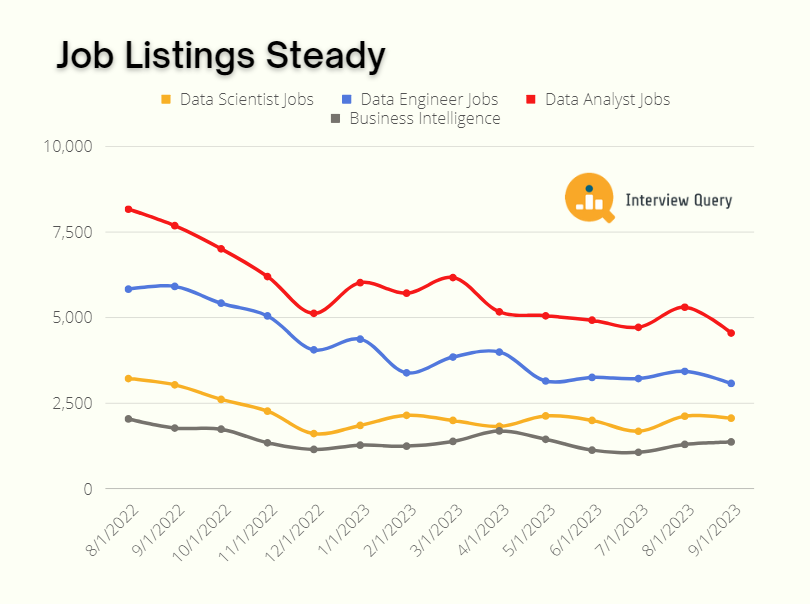The October 2023 Data Science Job Market Report
Overview
Overall in our October data science job market report, data science listings are in a holding position, with the exception of FAANG capturing a growing share of total postings and Business Intelligence taking off since the summer!
- Job Listings Steady – New postings have stabilized from fluctuations in previous months.
- Market Share of FAANG Jobs Rising - Since March 2023, we’ve seen this increase every month.
- Role Highlight: Business Intelligence – BI has proved more resilient than other roles since 2022.
Hiring Steady
On the back of strong US hiring, data science listings only slightly decreased from the boost in September.

Over the last three months, data science roles have increased by 3.2%, with data engineering falling by 5.4% and data analysts by 7.6%. At the height of the layoffs a year ago, many roles were experiencing a ten-point fluctuation month-to-month, so this current stability should be welcome news to job seekers.

FAANG Hiring on the Rise

All the way from their low market share of 0.54% in January 2023, FAANG has returned to near parity in September 2022 with 3.15% of all job listings. This market share has increased by an average of 32.9% each month since April as a result of both more FAANG listings and decreased postings in the industry overall.
The Resilience of Business Intelligence
YoY listings are down for BI, but still by a margin of around 10-20% less than other data science roles (22% for BI vs. 48% for Data Engineers and 32% for Data Scientists). Also, as pictured above, BI has seen a 21% jump in listings since June 2023, while other roles continue to fall. Both metrics support the idea that business intelligence could be a resilient field for displaced data scientists looking to transition.

Here’s a quick rundown of what business intelligence roles encompass and how to jump into the field.
Role Responsibilities:
- Purpose: BI roles provide essential context for business operations by analyzing historical and current data. Their main objective is to help companies make informed decisions by translating this data into actionable insights.
- Methods and Techniques: Data querying, reporting, dashboards, and descriptive analytics.
- Deploying Tools: Tableau, PowerBI, Qlik, and traditional relational databases (SQL Server, Oracle, etc.) are all regularly used in BI roles.
- Data Types: Unlike the unstructured databases that data scientists often operate with, BI roles primarily deal with structured data from relational databases.
Tips for Transitioning:
- Brush up on your communication skills– focus on presentation and writing skills, as a significant part of the BI role involves sharing insights with various stakeholders. This should include designing interpretable and actionable visualizations to complement your storytelling.
- Familiarize yourself with the above BI tools, and make sure you have a solid SQL foundation, especially for databases used by top companies.
- Review business concepts, especially those for operations, KPIs, strategic planning, and common jargon. The ability to reference these concepts in an interview can signal to the hiring team that you’re a good culture fit and can onboard quickly.
- Leverage your network to identify and review hot topics in the field and certifications that can help your application stand out. These same people may also be able to assist in hiring at their companies for open roles!
Already have a Business Intelligence interview lined up, or want to get a glimpse of what you’ll encounter? Check out these BI Interview Questions!
More Resources
Want to stay updated on market numbers? Subscribe to our newsletter to receive monthly data science job market updates!

